
In the struggle for beauty, various means are used, for example, fractional photothermolysis. This technology is very popular. It allows to get rid of many cosmetic problems in a short time and almost painlessly. Before agreeing to the procedure, you should familiarize yourself with the contraindications.
Fractional photothermolysis - what is it?
This procedure uses a laser. In the process of heating the skin, it causes focal destruction of cells. During its exposure, the skin gets a thermal burn. The diameter of such lesions can vary from 0. 1 to 0. 4 mm, and the depth is 0. 5 mm. Burns are point. Such damage to the epidermis stimulates tissue regeneration and collagen synthesis.
Fraxel laser resurfacing does not destroy melanocytes. For this reason, dark people do not develop hypopigmented spots after photothermolysis. The laser, on the other hand, promotes the redistribution of melanin, which evens out the skin tone. Fractional facial rejuvenation has the following advantages:
- can be used for both young (after 16 years) and aged skin;
- has a wide scope (eyelids, face, cleavage, etc. );
- lasting effect;
- can be held at any time of the year, including summer;
- can be applied to all skin types.
Ablative fractional photothermolysis
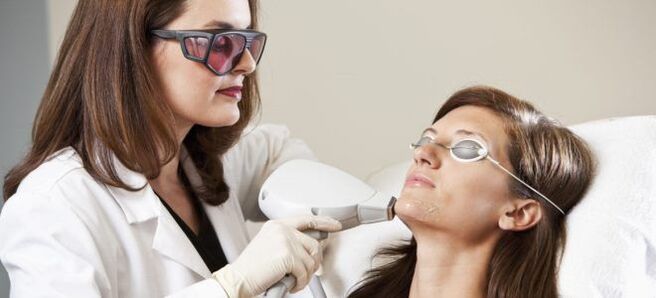
Erbium and CO2 lasers are used for this procedure. When exposed to the skin, the liquid in the cells of the epidermis is heated to 300 ° C. As a result, such areas evaporate, and in their place small open-type wounds are formed, surrounded by thermally coagulated cells. The process of restoring these "zones" takes a lot of time. Such fractional laser renewal is carried out in courses, each of which lasts from 2 to 6 sessions. It gives a wonderful lifting effect. However, when performed, the risk of skin tissue infection is high.
Nonablative fractional photothermolysis
Compared to the ablative procedure, this manipulation is considered milder. Such laser skin resurfacing using a fractional CO2 laser does not violate the integrity of the epidermis: there are no open wounds. The effect of such a procedure is less obvious than the ablative procedure, partly due to the fact that the rotten products are not removed, but remain in the thickness of the skin. Laser fractional photothermolysis is recommended to be carried out in courses, the duration of which can vary from 4 to 10 procedures. When they are implemented, the risk of skin infection is reduced to zero.
Fractional photothermolysis - indications

This cosmetic procedure has a wide field of application. Fractional photothermolysis treats scars, but that's not its only purpose. This procedure helps to solve the following problems:
- improves skin tone and elasticity;
- fights hyperpigmentation;
- removes solar keratosis;
- removes wrinkles;
- reduces pores;
- helps to get rid of stretch marks on the body;
- removes post-acne.
Fractional photothermolysis - contraindications
Not everyone can enjoy the results of such a procedure. Dermal optical thermolysis has the following contraindications:
- oncological diseases;
- chronic diseases in the acute stage;
- skin diseases;
- inflammatory processes in the body;
- mental illness;
- hormonal imbalance;
- pregnancy;
- lactation period;
- heart problem;
- blood diseases;
- diabetes;
- infectious diseases.
In addition, if mechanical dermabrasion was performed recently (less than two weeks ago), fractional photothermolysis is prohibited. Such procedures cannot be done after taking a solarium and sunbathing. High temperature and fever are contraindications for photothermolysis. It cannot be performed even if the integrity of the skin in the treatment area is broken.
Absolute contraindications for fractional photothermolysis are the following drugs:
- vitamin A;
- cytostatics;
- glucocorticoids;
- immunosuppressants.
Fraxel procedure
Fractional skin rejuvenation should be performed by an experienced cosmetologist with medical education. During the appointment, the specialist will objectively assess the condition of the skin and make sure that there are no contraindications to the procedure. In addition, before performing fractional laser therapy of the facial skin, the cosmetologist will warn the patient about possible complications that may occur after photothermolysis. Also, the specialist will definitely tell you how to properly care for your face or body during the recovery period.
Fractional photothermolysis - preparation
It starts 2 weeks before the proposed manipulation. It can be divided into the following stages:
- Refusal to use cosmetics that harm the skin. These include scrubs and peels. In addition, it is necessary to exclude the use of salicylic and glycolic acids and retinol. Such restrictions come into effect half a month before fractional photothermolysis.
- It is forbidden to visit the solarium and the beach a week before the procedure.
- You should start taking antibiotics and antiviral drugs prescribed by a cosmetologist 2-3 days before the manipulation. Such drugs will minimize the risk of inflammation or infection of the epidermis.
- Sports and other intensive physical activities should be stopped one day before fractional laser skin resurfacing. Consumption of alcoholic beverages at night is also prohibited.
Fractional laser resurfacing
The procedure lasts about an hour. Its implementation is carried out in several stages. Fractional photothermolysis of the face is performed as follows:
- The cosmetologist cleans the patient's skin with light peeling.
- The specialist applies anesthetic to the surface to be treated.
- After 40 minutes, the cosmetologist starts treating the face with a special nozzle. At this time, the patient may feel a slight tingling sensation. During the procedure, the skin is cooled by air flow, which reduces discomfort. The most problematic areas of the face are treated several times.
- Soothing cream is applied to the skin.
Fractional photothermolysis of eyelids
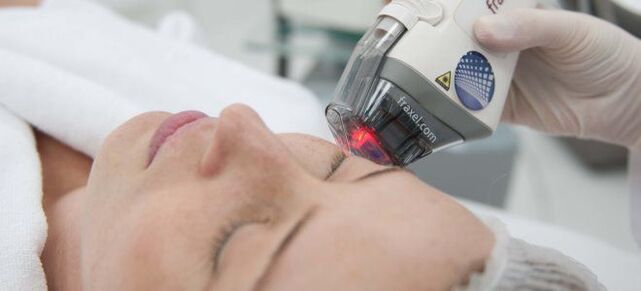
Since the skin around the eyes is very thin and sensitive, the lowest power laser is used to affect it. The most commonly used device with an Erbium rod. Its maximum allowed wavelength is 1420 nm. Before starting the fractional photothermolysis of the eyes, the cosmetologist puts special protective lenses on the patient. The procedure itself is carried out in the same way as when treating the skin of the face or body.
Fractional photothermolysis - side effects
This procedure is considered mild. If the patient has previously taken antibiotics and anti-inflammatory drugs prescribed by a specialist and followed all recommendations, then the risk of side effects is minimal. In addition, the skill of the cosmetologist depends on the fact that fraxel rejuvenation will be accompanied by complications. The more experienced he is, the more professionally the procedure will be performed and, therefore, the lower the risk of negative consequences.
Fractional laser photothermolysis is more often accompanied by such complications:
- swelling and redness in the treated area (ice compresses will help to eliminate);
- peeling (removed by moisturizer);
- bronzing effect (lasts 1-2 weeks).
If a skin infection occurs during fractional photothermolysis with an erbium laser, the following side effects may occur:
- streptoderma;
- erythema;
- bubbles (as after burning);
- hyperpigmentation;
- silly
Fraxel - rehabilitation
After the procedure, the skin needs special care. The duration of the recovery period and the final effect depend on following the cosmetologist's recommendations during this period. When Fraxel is used, you should follow the following instructions for skin care after the procedure:
- Continue to take antibiotics and antiviral drugs in the dosage indicated by the specialist for a certain period of time.
- If the procedure was performed by a man, you can shave only on the third day, and this should be done very carefully.
- You cannot play sports or expose the body to strong physical force for 48-72 hours after the manipulation.
- It is necessary to refuse the consumption of alcoholic beverages (this is a limitation for 2-3 days).
- It is forbidden to visit the solarium and the beach during the month. Don't forget to apply a cream with a high sun protection factor to the treated area of the skin before going outside.
- It is impossible to tear off the crust formed on the skin! He must fall upon himself.
- In the first weeks after the procedure, it is necessary to use local preparations designed for thermal burns to care for the treated area of the skin. During this time, moisturizing sprays will also be suitable.
- Chemical peels and scrubs should be abandoned for a month.
Fractional photothermolysis - effect
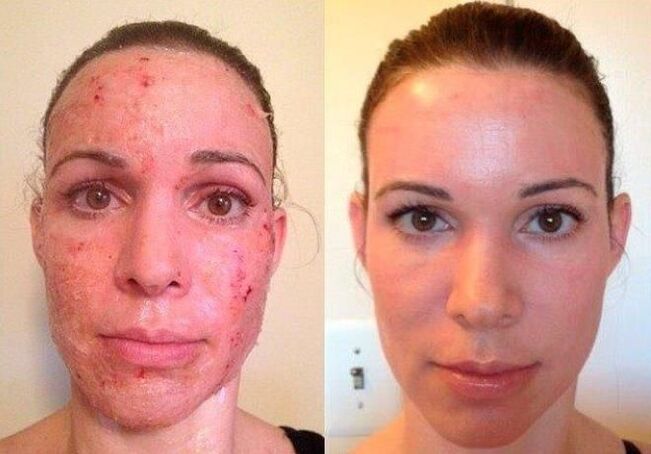
On the first day, the skin will look sunburnt. Photos of fractional photothermolysis immediately after the procedure are not impressive. With the non-ablative type of manipulation, recovery occurs in about 3-4 days. After the ablation procedure, this period lasts about a week. Even if one session improves the condition of the skin, it should not be limited to it. You have to go through the whole course: fractional photothermolysis before and after photos convince you of this.
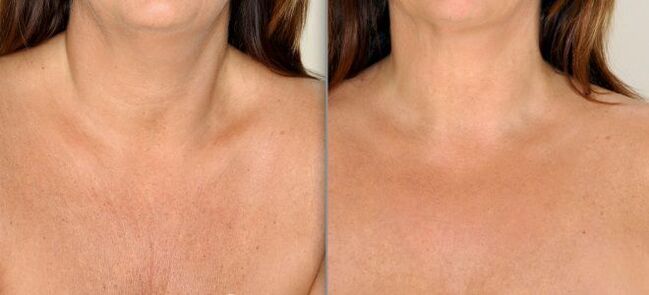

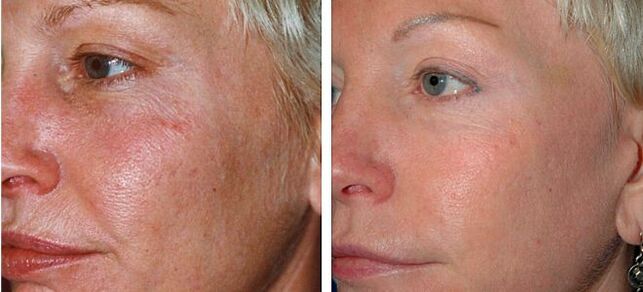
In each case, the duration of such therapy is determined by the cosmetologist. The interval between individual manipulations is 4-5 weeks. The duration of therapy depends on the problems to be solved:
- 3-4 sessions are recommended for rejuvenation;
- fractional photothermolysis of scars is represented by 6-8 procedures;
- 5-6 sessions of thermolysis are prescribed to deal with problem areas of the skin.
























